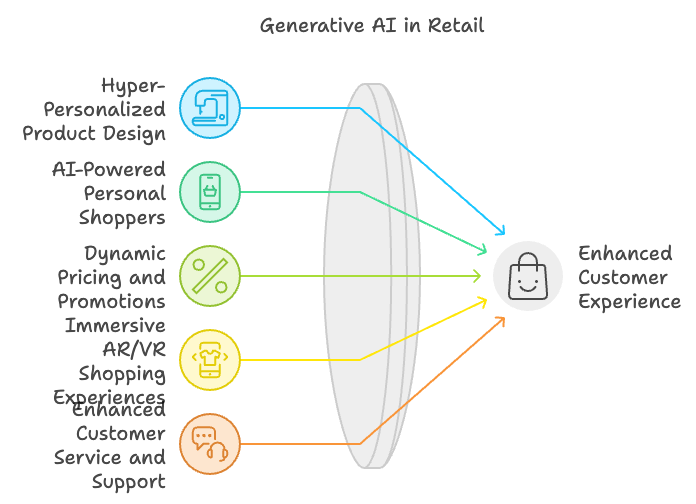Picture this: you’re walking down the street, minding your own business, when suddenly a drone zooms by overhead and drops a package right at your feet. You open it up and inside is the exact pair of shoes you’ve been eyeing online, in the perfect size and color. But here’s the thing – you never actually clicked “add to cart.”
This might sound like something out of a Black Mirror episode, but it’s not as far-fetched as you might think. Welcome to the wild world of generative AI for retail, where the line between science fiction and reality is blurrier than ever.
Wait, What Exactly is Generative AI?
Before we dive into all the ways artificial intelligence is about to make your shopping experience feel like a mind-bending episode of The Jetsons, let’s take a step back and make sure we’re all on the same page about what generative AI actually is.
Imagine you have a really smart friend who’s an amazing artist. You give them a photo of your dog and say, “hey, can you paint me a picture of Fluffy as a superhero?” A few days later, they come back with an incredibly realistic oil painting of your adorable pup wearing a cape and flying through the sky
Now imagine that friend is a computer, and instead of just being able to paint, it can create any kind of content you can dream up – text, audio, video, you name it.
That’s generative AI in a nutshell.
Here’s the really wild part: generative AI models can create this content without any human input, other than the initial prompt. They learn by analyzing massive amounts of existing data, whether that’s images, text, or audio, and then use that knowledge to generate completely new, original content that mimics what they’ve learned.
It’s like if your artist friend studied every single painting in the Louvre, internalized all the common techniques and styles, and then used that knowledge to paint you an original masterpiece in the style of their choice. Except in this case, your friend is a machine learning model and the Louvre is a massive dataset of content.
The Top 5 Generative AI Use Cases in Retail Industry
So what does this mean for the future of shopping? Let’s dive into some of the most mind-blowing gen AI use cases in retail industry that are going to make your jaw drop:
Hyper-Personalized Product Design
Remember that drone delivery scenario from earlier? Well buckle up, because that’s just the tip of the iceberg when it comes to personalized product design powered by generative AI.
Imagine walking into a clothing store, and instead of rifling through racks of generic sizes and styles, a friendly AI greets you at the door and asks about your personal style and preferences. Using that information, along with your measurements and body type, it generates a virtual “lookbook” of clothing items designed specifically for you, right down to the fit, color, and fabric.
But it doesn’t stop at fashion. Generative AI has the power to create hyper-personalized versions of just about any product you can imagine.
Furniture that’s perfectly sized for your space and designed to match your existing decor? Check.
A custom skincare regimen formulated for your exact skin type and concerns? No problem.
Heck, even your morning coffee could be optimized for your taste preferences and dietary needs.
The possibilities are endless, and it’s all thanks to the power of generative ai for retail. By analyzing vast amounts of customer data and using it to create individualized product recommendations and designs, retailers can provide a shopping experience that feels like it was made just for you – because it essentially was 😉
AI-Powered Personal Shoppers
Speaking of personalized experiences, let’s talk about the future of customer service in retail. Say goodbye to the days of wandering aimlessly through store aisles, trying to flag down an employee to ask for help. The future of retail is all about AI-powered personal shopping assistants that know your preferences better than you know yourself.
Picture this: you’re scrolling through your favorite online clothing retailer, and a chat window pops up. But instead of a generic “how can I help you today?” message, the AI on the other end greets you by name and asks if you’re looking for anything specific. You mention that you have a wedding coming up and need a dress, and the AI immediately starts generating personalized recommendations based on your size, style, and budget.
But the real magic happens when you click on one of the recommended dresses and an AI-generated image of yourself wearing the dress appears on the screen. No more guessing how something will look on your body type – you can see it right in front of you, thanks to the power of generative AI.
And it’s not just online shopping that’s getting the AI personal shopper treatment. In-store AI assistants are becoming increasingly common, using natural language processing and computer vision to provide personalized recommendations and even guide you to the exact location of products on store shelves.
It’s like having a personal stylist, interior designer, and product expert all rolled into one – and it’s all powered by the magic of artificial intelligence in retail.
Dynamic Pricing and Promotions
Have you ever noticed how prices for the same product can vary wildly depending on where and when you shop? That’s because many retailers use dynamic pricing algorithms to adjust prices in real-time based on factors like supply and demand, competitor pricing, and even the weather.
But with generative AI, dynamic pricing is getting even smarter. By analyzing vast amounts of customer data and market trends, AI models can generate hyper-targeted promotions and discounts that are tailored to individual shoppers’ preferences and behaviors.
For example, let’s say you’ve been eyeing a particular pair of sneakers online, but you’re hesitant to pull the trigger because of the price. With generative AI, the retailer could analyze your browsing and purchase history, along with data on your demographics and location, and generate a personalized discount code just for you – one that’s designed to nudge you over the edge and convince you to make the purchase.
But it’s not just about getting shoppers to buy more stuff. Generative AI can also help retailers optimize their pricing and inventory strategies to reduce waste and improve efficiency. By analyzing data on consumer demand and market trends, AI models can help retailers make more informed decisions about what products to stock, when to discount items, and how to allocate inventory across different store locations and channels.
It’s like having a team of data scientists and financial analysts working around the clock to help you make smarter, more profitable pricing and inventory decisions – all thanks to the power of generative ai for retail.
Immersive AR/VR Shopping Experiences
Online shopping is convenient, but let’s be real – sometimes you just need to see how that couch will look in your actual living room before you commit to buying it. That’s where generative AI comes in, powering immersive augmented reality (AR) and virtual reality (VR) shopping experiences that blur the lines between online and offline retail.
Imagine being able to generate a photorealistic 3D model of any product you’re considering purchasing, whether it’s a piece of furniture, a pair of shoes, or a new kitchen appliance. With AR technology, you could superimpose that 3D model onto a real-time view of your space, using your smartphone or tablet as a “magic window” to see how the item would look in your home or on your body.
But why stop at individual products? With generative AI, retailers could create entire virtual showrooms and store environments that allow shoppers to browse and interact with products in a fully immersive way. Imagine being able to walk through a virtual furniture store, sitting on couches and opening dresser drawers as if you were really there – all from the comfort of your own home.
And for clothing and accessory retailers, VR try-on experiences powered by generative AI could be a game-changer. Imagine being able to generate a virtual avatar that looks and moves just like you, and then using that avatar to try on clothes and accessories in a virtual dressing room. You could see how different items look on your body type and skin tone, mix and match different outfits, and even walk around and see how the clothes move and drape in real-time.
The possibilities are endless, and they’re all made possible by the power of generative AI. By creating these immersive, hyper-realistic shopping experiences, retailers can give customers the confidence to make purchases without ever setting foot in a physical store – and that’s a win-win for everyone.
Enhanced Customer Service and Support
Last but not least, let’s talk about how generative AI is transforming the way retailers approach customer service and support.
Picture this: you’ve just purchased a new smart home device from your favorite electronics retailer, but you’re having trouble getting it set up. You visit the retailer’s website and click on the “support” link, expecting to have to wade through pages of dense user manuals and FAQ articles to find the answer you need.
But instead, you’re greeted by a friendly AI chatbot that asks about the problem you’re experiencing. Using natural language processing and machine learning, the chatbot is able to quickly diagnose the issue and generate step-by-step instructions for resolving it – all in a matter of seconds.
And if the issue is too complex for the chatbot to handle on its own, it can seamlessly escalate the conversation to a human support representative – but not before using generative AI to provide that representative with a detailed summary of the problem and the steps that have already been taken to try to resolve it.
This not only saves time for the customer, but it also helps support teams be more efficient and effective in their interactions with customers. And with generative AI constantly learning and improving based on each interaction, the quality and accuracy of those interactions will only continue to get better over time.
But generative AI isn’t just transforming the way retailers handle reactive customer support – it’s also enabling proactive, personalized customer service that anticipates needs and solves problems before they even arise.
For example, imagine you’ve been browsing a retailer’s website for a while, adding items to your cart but never quite pulling the trigger on a purchase. With generative AI, that retailer could analyze your browsing behavior and generate a personalized email or push notification with a special discount code or free shipping offer – just the nudge you need to complete the purchase.
Or let’s say you’ve purchased a new fitness tracker from a sporting goods retailer. With generative AI, that retailer could use data from your device to generate personalized workout recommendations and coaching tips, helping you get the most out of your purchase and reach your fitness goals faster.
The possibilities are endless, and they’re all powered by the magic of generative AI. By using this technology to create more personalized, proactive, and efficient customer service experiences, retailers can build deeper, more meaningful relationships with their customers – and that’s a win for everyone.

ChatCube: Your Secret Weapon for AI-Powered Customer Support
Now, I know what you might be thinking:
“This all sounds great, but I’m not a tech giant with a team of AI experts at my disposal. How can I possibly harness the power of generative AI for my own retail business?”
Enter ChatCube: the no-code, easy-breezy solution for creating custom ChatGPT-like chatbots that are trained on your own data.
Imagine being able to set up a chatbot for your business in less time than it takes to make a cup of coffee. With ChatCube, that’s not just a pipe dream – it’s a reality.
Here’s how it works: you simply upload your own data (think product information, FAQs, customer support logs) to ChatCube, and the platform’s AI algorithms will use that data to train a custom chatbot that can answer customer questions and generate leads – all in the same natural, conversational style as ChatGPT.
But what happens when a customer asks a question that stumps the chatbot? No worries – ChatCube has a seamless human handoff feature that allows the bot to transfer the conversation to a real-life support agent when needed. It’s like having an AI-powered sidekick that knows when to tag in a human teammate.
And here’s the really amazing part: as you create new content and gather more customer data over time, you can retrain your chatbot with just a single click. That means your bot is always learning, always improving, and always staying up-to-date with the latest information about your products and services.
Imagine the impact this could have on your customer support operations. Instead of having to field every inquiry manually, your human agents could focus on the most complex and high-stakes issues, while the chatbot handles the rest with speed and precision.
It’s like having a superhuman customer support team that never sleeps, never gets overwhelmed, and never loses patience – even when dealing with the most demanding customers.
And the benefits don’t stop there. By providing instant, accurate answers to common questions, your ChatCube-powered chatbot can help reduce customer frustration and increase satisfaction. It can also gather valuable data on customer preferences and pain points, helping you optimize your products and services over time.
So if you’re a retailer looking to harness the power of generative ai for retail, ChatCube is the perfect place to start. With its no-code setup, custom training, and human handoff capabilities, it’s the secret weapon you need to take your customer support to the next level – without breaking the bank or hiring a team of AI experts.
Real-World Examples: Retailers Embracing Generative AI
While the use cases we’ve explored might sound like science fiction, the truth is that many retailers are already using generative AI to transform the shopping experience. Here are just a few examples:
- Stitch Fix: This online personal styling service uses generative AI to create hyper-personalized clothing recommendations for each of its customers. By analyzing data on customers’ style preferences, body types, and purchase history, Stitch Fix’s AI algorithms can generate tailored selections of clothing and accessories that are more likely to result in satisfied customers and higher sales.
- Wayfair: The online home goods retailer uses generative AI to create 3D models of its products, allowing customers to visualize how furniture and decor items will look in their own homes using AR technology. Wayfair’s AI algorithms can also generate personalized product recommendations based on customers’ browsing and purchase history, helping to drive sales and reduce returns.
- Sephora: The beauty retailer uses generative AI to power its Virtual Artist app, which allows customers to try on makeup virtually using their smartphone camera. By analyzing a customer’s facial features and skin tone, the app can generate realistic images of how different products will look on their face, taking the guesswork out of online makeup shopping.
- Nike: The athletic apparel giant uses generative AI to create hyper-personalized shoe designs based on customers’ unique foot shape and gait. By analyzing data from customers’ feet and running patterns, Nike’s AI algorithms can generate custom shoe designs that provide optimal support and performance for each individual wearer.
- Amazon: The e-commerce behemoth uses generative AI in a variety of ways, from creating personalized product recommendations to optimizing pricing and inventory strategies. Amazon’s AI algorithms can even generate new product designs based on customer feedback and sales data, helping the company stay ahead of the curve in an ever-evolving retail landscape.
These are just a few examples of how generative ai for retail is already being used by major players in the industry. As the technology continues to evolve and mature, we can expect to see even more retailers embracing the power of AI to create hyper-personalized, immersive shopping experiences that delight customers and drive sales.
The Future of Retail: Powered by Generative AI
So there you have it – five of the most mind-blowing ways that generative AI is transforming the retail industry as we know it. From hyper-personalized product design and dynamic pricing to immersive AR/VR experiences and proactive customer service, the gen ai use cases in retail industry are almost too many to count.
But here’s the thing – we’re just scratching the surface of what’s possible with this incredible technology. As generative AI continues to evolve and mature, we can expect to see even more transformative use cases emerge in the years to come.
Of course, as with any powerful technology, there are challenges and uncertainties to be navigated along the way. Retailers will need to be thoughtful and responsible in their use of generative AI, ensuring that they’re using it in ways that benefit customers and society as a whole.
There are also valid concerns around data privacy, algorithmic bias, and the potential for job displacement as AI takes on more tasks traditionally performed by human workers. But with the right policies and safeguards in place, the benefits of generative AI for retailers and consumers alike are simply too great to ignore.
So buckle up, because the future of retail is here – and it’s powered by the incredible, mind-bending magic of generative AI. Whether you’re a retailer looking to stay ahead of the curve or a consumer excited about the possibilities of hyper-personalized, immersive shopping experiences, one thing is clear: the artificial intelligence retail revolution is just getting started, and the best is yet to come.
What is an example of generative AI use cases in retail?
One example of generative AI use cases in retail is hyper-personalized product design. By analyzing customer data, AI algorithms can generate custom product designs tailored to individual preferences, such as clothing, furniture, or accessories.
What is the use case of AI in retail?
AI has several use cases in retail, including personalized product recommendations, dynamic pricing, inventory management, customer service chatbots, and sentiment analysis of customer feedback.
What is Google generative AI for retail?
Google offers various generative AI tools and platforms that retailers can leverage, such as Google Cloud AI Platform, which includes services for image and text generation, translation, and more. These tools can help retailers create personalized content, improve customer engagement, and streamline operations.
How is GenAI changing retail?
GenAI is transforming retail by enabling hyper-personalization, automating tasks, and enhancing customer experiences. From custom product design to AI-powered chatbots, GenAI helps retailers better understand and serve their customers while optimizing operations.
What are three ways in which the power of generative AI technologies is transforming the retail experience?
Three ways generative AI is transforming retail: 1) Personalized product recommendations based on customer data; 2) Immersive AR/VR shopping experiences that allow customers to virtually try products; 3) AI-powered chatbots that provide instant, contextual customer support.
How is AI changing consumer interaction with retailers?
AI is making consumer interactions with retailers more personalized, convenient, and efficient. Through chatbots, recommendation engines, and personalized content, AI helps retailers deliver tailored experiences that meet individual customer needs and preferences.
How will AI affect the retail industry in 5 years from now?
In 5 years, AI is expected to be even more deeply integrated into retail operations, from supply chain management to customer service. Retailers will likely rely on AI to drive personalization, automation, and data-driven decision-making across all aspects of their business.
How is AI disrupting the retail industry?
AI is disrupting retail by changing the way companies understand and serve customers, automate processes, and make decisions. By leveraging AI, retailers can gain a competitive edge through personalization, efficiency, and innovation.
What is a key way AI has helped online retailers become more successful?
One key way AI has helped online retailers succeed is through personalized product recommendations. By analyzing customer data, AI algorithms can suggest products that match individual preferences, increasing sales and customer satisfaction.
What is the retail AI strategy?
A retail AI strategy involves leveraging artificial intelligence technologies to improve various aspects of the retail business, such as customer experience, supply chain management, and operational efficiency. This strategy may include implementing chatbots, recommendation engines, demand forecasting models, and more.
What are the disadvantages of AI shopping?
Some potential disadvantages of AI shopping include privacy concerns around data collection and usage, the risk of algorithmic bias leading to unfair or discriminatory outcomes, and the potential for job displacement as AI automates certain tasks. Additionally, some customers may prefer human interaction over AI-powered experiences.





